Field marshal (United Kingdom)
| Field Marshal | |
|---|---|
 The insignia of a field marshal as worn on epaulettes | |
| Country | |
| Service branch | |
| Abbreviation | FM |
| Rank | Five-star rank |
NATO rank | OF-10 |
| Non-NATO rank | O-11 |
| Formation | 1736 |
| Next lower rank | General |
| Equivalent ranks | Admiral of the Fleet (RN) Marshal of the Royal Air Force (RAF) |
Field Marshal has been the highest rank in the British Army since 1736. A five-star rank with NATO code OF-10, it is equivalent to an Admiral of the Fleet in the Royal Navy or a Marshal of the Royal Air Force in the Royal Air Force (RAF). A Field Marshal's insignia consists of two crossed batons surrounded by yellow leaves below St Edward's Crown. Like Marshals of the RAF and Admirals of the Fleet, Field Marshals traditionally remain officers for life, though on half-pay when not in an appointment.[1][2] The rank has been used sporadically throughout its history and was vacant during parts of the 18th and 19th centuries (when all former holders of the rank were deceased). After the Second World War, it became standard practice to appoint the Chief of the Imperial General Staff (later renamed Chief of the General Staff) to the rank on his last day in the post. Army officers occupying the post of Chief of the Defence Staff, the professional head of all the British Armed Forces, were usually promoted to the rank upon their appointment.[3]
In total, 141 men have held the rank of field marshal. The majority led careers in the British Army or the British Indian Army, rising through the ranks to eventually become a field marshal. Some members of the British Royal Family—most recently Prince Edward, Duke of Kent, and Charles, Prince of Wales—were promoted to the rank after shorter periods of service. Three British monarchs—George V, Edward VIII, and George VI— assumed the rank on their accessions to the throne, while Edward VII was already a field marshal, and two British consorts—Albert, Prince Consort and Prince Philip, Duke of Edinburgh—were appointed by their respective queens. Other ceremonial appointments were made as diplomatic gestures. Twelve foreign monarchs held the honour, though three (Wilhelm II, German Emperor; Franz Joseph I, Austrian Emperor; and Hirohito, Emperor of Japan) were stripped of it when their countries became enemies of Britain and her allies in the two world wars. Also awarded the rank were one Frenchman (Ferdinand Foch) and one Australian (Sir Thomas Blamey), honoured for their contributions to World War I and World War II respectively, and one foreign statesman (Jan Smuts).[3]
A report commissioned by the Ministry of Defence in 1995 made a number of recommendations for financial savings in the armed forces' budget, one of which was the abolition of the five-star ranks. Part of the rationale was that these ranks were disproportionate to the size of the forces commanded by these officers and that none of the United Kingdom's close allies, such as the United States (which reserves the rank of general of the army for officers who have commanded large armies in major wars), used such ranks. The recommendation was not taken up in full, but the practice of promoting service chiefs to five-star ranks was stopped and the ranks are now reserved for special circumstances. Sir Peter Inge was, in 1994, the last active officer to be promoted to the rank. Inge relinquished the post of Chief of the Defence Staff (CDS) in 1997 and his successor, Sir Charles Guthrie, was the first officer not to be promoted upon appointment as CDS.[3]
The most recent promotions to field marshal came in 2012, eighteen years after the moratorium on routine promotions to the rank, when Queen Elizabeth II promoted Prince Charles, her son and heir apparent, to the five-star ranks in all three services, in recognition of support provided for her in her capacity as Commander-in-Chief of the British Armed Forces.[4] At the same time, Guthrie, who relinquished the post of CDS and retired from active service in 2001, was promoted to honorary field marshal.[5] In June 2014 former Chief of the Defence Staff Lord Walker of Aldringham was also promoted to honorary field marshal.[6]
Although the rank of field marshal is not used in the Royal Marines, the insignia is used on the uniform of the Captain General, the ceremonial head of the corps (equivalent to colonel-in-chief).[7]
Contents
1 Insignia of rank
2 List of field marshals
3 Notes
4 References
Insignia of rank

Field Marshal's uniform and baton (pertaining to the late Sir John Stanier) on display in the Royal Scots Dragoon Guards Museum, Edinburgh Castle.
The rank insignia of a field marshal in the British Army comprises two crossed batons in a wreath of oak leaves, with a crown above. In some other countries, historically under the sphere of British influence, an adapted version of the insignia is used for field marshals, often with the crown being replaced with an alternative cultural or national emblem. On appointment, British field marshals are awarded a gold-tipped baton which they may carry on formal occasions.
List of field marshals

Four field marshals were also recipients of the Victoria Cross, the UK's highest award for gallantry.
The vast majority of officers to hold the rank of field marshal were professional soldiers in the British Army, though eleven served as officers in the British Indian Army. At least fifty-seven field marshals were wounded in battle earlier in their careers, of whom 24 were wounded more than once, and eight had been prisoners of war. Fifteen future field marshals were present at the Battle of Vitoria, where the Duke of Wellington earned the rank, and ten others served under Wellington at the Battle of Waterloo. However, only thirty-eight held independent commands in the field, and just twelve served as Commander-in-Chief of the Forces (the pre-1904 professional head of the army) or Chief of the Imperial General Staff during a major war.[3]
Four field marshals—Sir Evelyn Wood, Sir George White, Earl Roberts, and Lord Gort—had previously received the Victoria Cross (VC), the United Kingdom's highest and most prestigious award for gallantry "in the face of the enemy". Wood, a famously injury-prone officer, was awarded the VC for two actions in 1858 in which he first attacked a group of rebels in India and later rescued an informant from another group of rebels. White, a cavalry officer, led two charges on enemy guns in Afghanistan in 1879, while Gort, of the Grenadier Guards, commanded a series of attacks while severely wounded during the First World War in 1918. Roberts received his VC for actions during the Indian Mutiny.[8][9][10][11][12]
Wellington, 44 at the time of his promotion, was the youngest non-royal officer to earn the rank of field marshal. Charles Moore, 1st Marquess of Drogheda was the oldest, promoted at the age of 91, while a further twenty-three officers were promoted to field marshal in their eighties. Wellington was also the only field marshal to become Prime Minister of the United Kingdom,[3] though several others served as cabinet ministers.
No officer whose career was spent in the British Army has ever reached the rank of field marshal without having served in the cavalry, infantry, Royal Armoured Corps, Royal Artillery or Royal Engineers.[3] Two non-British officers have been appointed field marshals in the British Army—Ferdinand Foch of France and Sir Thomas Blamey of Australia, in recognition of their contributions in the First and Second World Wars respectively—while only one, Sir William Robertson, held every rank in the British Army, from private soldier to field marshal.[3][13][14][15]
| Name and style[a] | Regiment[b] | Image | Born | Died | Date of promotion[16] |
|---|---|---|---|---|---|
George Hamilton, 1st Earl of Orkney | Royal Regiment of Foot |  | 1666 | 1737 | 1736-01-1212 January 1736[17] |
John Campbell, 2nd Duke of Argyll | Earl of Argyll's Regiment of Foot | 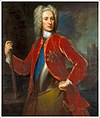 | 1680 | 1743 | 1736-01-1414 January 1736[18] |
Richard Boyle, 2nd Viscount Shannon | Horse Guards Regiment |  | 1674 | 1740 | 17392 July 1739[19] |
François de La Rochefoucauld, Marquis de Montandre |  | 1672 | 1739 | 17392 July 1739[20] | |
John Dalrymple, 2nd Earl of Stair | 26th (Cameronian) Regiment of Foot |  | 1673 | 1747 | 1742-03-1818 March 1742[21] |
Richard Temple, 1st Viscount Cobham | 6th Regiment of Foot |  | 1669 | 1749 | 1742-12-1414 December 1742[22] |
George Wade | Earl of Bath's Regiment |  | 1673 | 1748 | 1742-12-1414 December 1742[23] |
Sir Robert Rich, 4th Baronet | Grenadier Guards (1st Foot Guards) | 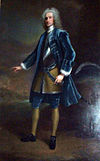 | 1685 | 1768 | 1757-11-2828 November 1757[24] |
Richard Molesworth, 3rd Viscount Molesworth | Royal Scots |  | 1680 | 1758 | 1757-11-2929 November 1757[25] |
John Ligonier, 1st Earl Ligonier | 10th Regiment of Foot |  | 1680 | 1770 | 1757-11-3030 November 1757[26] |
James O'Hara, 2nd Baron Tyrawley | 39th (Dorsetshire) Regiment of Foot |  | 1690 | 1773 | 17631 June 1763[27] |
Henry Seymour Conway | 5th Royal Irish Lancers |  | 1721 | 1794 | 1793-10-1212 October 1793[28] |
Prince William Henry, Duke of Gloucester and Edinburgh | 13th Regiment of Foot |  | 1743 | 1805 | 1793-10-1212 October 1793[29] |
Sir George Howard | 24th Regiment of Foot |  | 1720 | 1796 | 1793-10-1212 October 1793[30] |
Prince Frederick, Duke of York and Albany | Grenadier Guards | 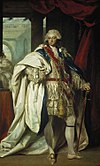 | 1763 | 1827 | 1795-02-1010 February 1795[31] |
John Campbell, 5th Duke of Argyll | Royal Scots Fusiliers |  | 1723 | 1806 | 1796-07-3030 July 1796[32] |
Jeffery Amherst, 1st Baron Amherst | Grenadier Guards |  | 1717 | 1797 | 1796-07-3030 July 1796[33] |
John Griffin, 4th Baron Howard de Walden | Scots Guards |  | 1719 | 1797 | 1796-07-3030 July 1796[34] |
Studholme Hodgson | Grenadier Guards |  | 1708 | 1798 | 1796-07-3030 July 1796[35] |
George Townshend, 1st Marquess Townshend | 7th Queen's Own Hussars |  | 1724 | 1807 | 1796-07-3030 July 1796[36] |
Lord Frederick Cavendish | Coldstream Guards | 1729 | 1803 | 1796-07-3030 July 1796[37] | |
Charles Lennox, 3rd Duke of Richmond | Coldstream Guards |  | 1735 | 1806 | 1796-07-3030 July 1796[38] |
Prince Edward, Duke of Kent and Strathearn | Royal Fusiliers |  | 1767 | 1820 | 18055 September 1805[39] |
Arthur Wellesley, 1st Duke of Wellington | 33rd Regiment of Foot |  | 1769 | 1852 | 1813-06-2121 June 1813[40] |
Prince Ernest Augustus, Duke of Cumberland and Teviotdale | — (Royal Family; afterwards King of Hanover) |  | 1771 | 1851 | 18136 November 1813[41] |
Prince Adolphus, Duke of Cambridge | Hanoverian Guards |  | 1774 | 1850 | 1813-11-2626 November 1813[42] |
Prince William Frederick, Duke of Gloucester and Edinburgh | Scots Guards |  | 1776 | 1834 | 181624 May 1816[43] |
Prince Leopold of Saxe-Coburg and Gotha | — (Royal Family; afterwards King of the Belgians) |  | 1790 | 1865 | 181624 May 1816[44] |
Charles Moore, 1st Marquess of Drogheda | 12th Dragoons |  | 1730 | 1821 | 1821-07-1919 July 1821[45] |
William Harcourt, 3rd Earl Harcourt | Grenadier Guards |  | 1743 | 1830 | 1821-07-1919 July 1821[17] |
Sir Alured Clarke | 50th (Queen's Own) Regiment of Foot |  | 1745 | 1832 | 1830-07-2222 July 1830[46] |
Sir Samuel Hulse | Grenadier Guards |  | 1747 or 1748 | 1837 | 1830-07-2222 July 1830[47] |
Prince Albert of Saxe-Coburg and Gotha | — (Royal Family) |  | 1819 | 1861 | 18408 February 1840[48] |
William II | — (King of the Netherlands) |  | 1792 | 1847 | 184528 July 1845[49] |
Sir George Nugent, 1st Baronet | 39th (Dorsetshire) Regiment of Foot |  | 1757 | 1849 | 1846-11-099 November 1846[50] |
Thomas Grosvenor | Grenadier Guards |  | 1764 | 1851 | 1846-11-099 November 1846[51] |
Henry Paget, 1st Marquess of Anglesey | 80th Regiment of Foot (Staffordshire Volunteers) |  | 1768 | 1854 | 1846-11-099 November 1846[52] |
FitzRoy Somerset, 1st Baron Raglan | 4th Light Dragoons |  | 1788 | 1855 | 18545 November 1854[53] |
Stapleton Cotton, 1st Viscount Combermere | 23rd Regiment of Foot | 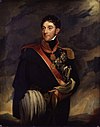 | 1773 | 1865 | 1855-10-022 October 1855[54] |
John Byng, 1st Earl of Strafford | 33rd Regiment of Foot |  | 1772 | 1860 | 1855-10-022 October 1855[55] |
Henry Hardinge, 1st Viscount Hardinge | Queen's Rangers | 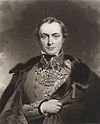 | 1785 | 1856 | 1855-10-022 October 1855[56] |
John Colborne, 1st Baron Seaton | East Devonshire Regiment |  | 1779 | 1863 | 18601 April 1860[57] |
Sir Edward Blakeney | 99th Regiment of Foot |  | 1778 | 1868 | 18629 November 1862[58] |
Hugh Gough, 1st Viscount Gough | Seaforth Highlanders |  | 1779 | 1869 | 18629 November 1862[59] |
Prince George, Duke of Cambridge | 12th Royal Lancers |  | 1819 | 1904 | 18629 November 1862[60] |
Colin Campbell, 1st Baron Clyde | 9th (East Norfolk) Regiment of Foot |  | 1792 | 1863 | 18629 November 1862[61] |
Sir Alexander Woodford | 9th (East Norfolk) Regiment of Foot |  | 1782 | 1870 | 18681 January 1868[62] |
Sir William Gomm | 9th (East Norfolk) Regiment of Foot |  | 1784 | 1875 | 18681 January 1868[63] |
Sir Hew Ross | Royal Artillery |  | 1779 | 1868 | 18681 January 1868[64] |
Sir John Burgoyne | Royal Engineers |  | 1782 | 1871 | 18681 January 1868[65] |
Sir George Pollock, 1st Baronet | Bengal Artillery | 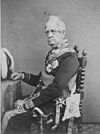 | 1786 | 1872 | 187024 May 1870[66] |
Sir John FitzGerald | — (Retired) | 1785 | 1877 | 1875-05-2929 May 1875[67] | |
George Hay, 8th Marquess of Tweeddale | Grenadier Guards |  | 1787 | 1876 | 1875-05-2929 May 1875[68] |
Edward VII | — (Royal Family) |  | 1841 | 1910 | 187529 May 1875[69] |
Sir William Rowan | 52nd (Oxfordshire) Regiment of Foot |  | 1789 | 1879 | 1877-06-022 June 1877[70] |
Sir Charles Yorke | 35th (Royal Sussex) Regiment of Foot | 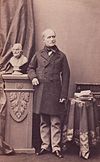 | 1790 | 1880 | 1877-06-022 June 1877[71] |
Hugh Rose, 1st Baron Strathnairn | 93rd (Sutherland Highlanders) Regiment of Foot |  | 1801 | 1885 | 1877-06-022 June 1877[72] |
Robert Napier, 1st Baron Napier of Magdala | Bengal Engineer Group |  | 1810 | 1890 | 1883-01-011 January 1883[73] |
Sir Patrick Grant | 11th Bengal Native Infantry |  | 1804 | 1895 | 1883-06-2424 June 1883[74] |
Sir John Michel | 64th (2nd Staffordshire) Regiment of Foot |  | 1804 | 1886 | 1886-03-2727 March 1886[75] |
Sir Richard Dacres | Royal Artillery | 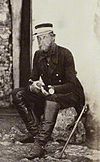 | 1799 | 1886 | 1886-03-2727 March 1886[76] |
Lord William Paulet | 85th Regiment of Foot (Bucks Volunteers) |  | 1804 | 1893 | 1886-07-1010 July 1886[77] |
George Bingham, 3rd Earl of Lucan | 6th Regiment of Foot |  | 1800 | 1888 | 188721 June 1887[78] |
Sir Lintorn Simmons | Royal Engineers |  | 1821 | 1903 | 1890-05-2121 May 1890[79] |
Sir Frederick Haines | 4th Regiment of Foot |  | 1818 | 1909 | 1890-05-2121 May 1890[80] |
Sir Donald Stewart, 1st Baronet | 9th Bengal Native Infantry |  | 1824 | 1900 | 1894-05-2426 May 1894[81] |
Garnet Wolseley, 1st Viscount Wolseley | 12th Regiment of Foot |  | 1833 | 1913 | 1894-05-2426 May 1894[82] |
Frederick Roberts, 1st Earl Roberts, VC | Bengal Artillery | 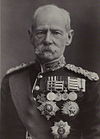 | 1832 | 1914 | 189525 May 1895[83] |
Prince Edward of Saxe-Weimar | 67th (South Hampshire) Regiment of Foot |  | 1823 | 1902 | 189722 June 1897[84] |
Sir Neville Bowles Chamberlain | 55th Bengal Native Infantry |  | 1820 | 1902 | 190025 April 1900[85] |
Wilhelm II, German Emperor | — (German Emperor) | 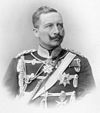 | 1859 | 1941 | 190127 January 1901[86] |
Sir Henry Norman | 1st Bengal Native Infantry |  | 1826 | 1904 | 1902-06-2626 June 1902[87] |
Prince Arthur, Duke of Connaught and Strathearn | Royal Engineers | 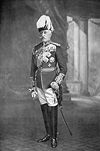 | 1850 | 1942 | 1902-06-2626 June 1902[88] |
Sir Evelyn Wood, VC | 13th Light Dragoons |  | 1838 | 1919 | 1903-04-088 April 1903[89] |
Sir George White, VC | 27th (Inniskilling) Regiment of Foot |  | 1835 | 1912 | 1903-04-088 April 1903[90] |
Franz Joseph I of Austria | — (Emperor of Austria; King of Hungary) |  | 1830 | 1916 | 19031 September 1903[91] |
Francis Grenfell, 1st Baron Grenfell | King's Royal Rifle Corps |  | 1841 | 1925 | 1908-04-1111 April 1908[92] |
Sir Charles Brownlow | 51st Sikhs (Frontier Force) |  | 1831 | 1916 | 1908-06-2020 June 1908[93] |
Herbert Kitchener, 1st Earl Kitchener | Royal Engineers |  | 1850 | 1916 | 190910 September 1909[94] |
George V | Royal Welsh Fusiliers — (Royal Family) |  | 1865 | 1936 | 19107 May 1910[95] |
Paul Methuen, 3rd Baron Methuen | Scots Guards |  | 1845 | 1932 | 1911-06-1919 June 1911[96] |
William Nicholson, 1st Baron Nicholson | Royal Engineers |  | 1845 | 1918 | 1911-06-1919 June 1911[97] |
John French, 1st Earl of Ypres | 8th King's Royal Irish Hussars |  | 1852 | 1925 | 19133 June 1913[98] |
Nicholas II of Russia | — (Emperor of Russia) |  | 1868 | 1918 | 19161 January 1916[99] |
Douglas Haig, 1st Earl Haig | 7th Queen's Own Hussars |  | 1861 | 1928 | 1917-01-011 January 1917[100] |
Sir Charles Egerton | 31st (Huntingdonshire) Regiment of Foot |  | 1848 | 1921 | 1917-03-1616 March 1917[101] |
Emperor Taishō (Yoshihito) | — (Emperor of Japan) |  | 1879 | 1926 | 19181 January 1918[102] |
Ferdinand Foch | 35th Artillery Regiment — (French Army) |  | 1851 | 1929 | 191919 July 1919[14] |
Herbert Plumer, 1st Viscount Plumer | York and Lancaster Regiment | 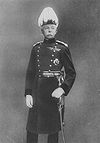 | 1857 | 1932 | 1919-07-3131 July 1919[103] |
Edmund Allenby, 1st Viscount Allenby | 6th (Inniskilling) Dragoons | 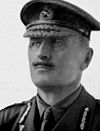 | 1861 | 1936 | 1919-07-3131 July 1919[104] |
Sir Henry Wilson, 1st Baronet | Rifle Brigade (Prince Consort's Own) |  | 1864 | 1922 | 1919-07-3131 July 1919[105] |
Sir William Robertson, 1st Baronet | 3rd Dragoon Guards |  | 1860 | 1933 | 192029 March 1920[106] |
Sir Arthur Barrett | 44th (East Essex) Regiment of Foot |  | 1857 | 1926 | 192112 April 1921[107] |
Albert I of Belgium | — (King of Belgium) |  | 1875 | 1934 | 19214 July 1921[108] |
William Birdwood, 1st Baron Birdwood | Royal Scots Fusiliers | 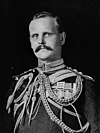 | 1865 | 1951 | 192520 March 1925[109] |
Sir Claud Jacob | Worcestershire Regiment | 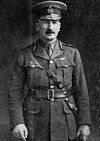 | 1863 | 1948 | 192630 November 1926[110] |
George Milne, 1st Baron Milne | Royal Artillery |  | 1866 | 1948 | 192830 January 1928[111] |
Alfonso XIII of Spain | — (King of Spain) |  | 1886 | 1941 | 1928-06-033 June 1928[112] |
Hirohito (Emperor Shōwa) | — (Emperor of Japan) |  | 1901 | 1989 | 1928-06-2626 June 1928[113] |
Julian Byng, 1st Viscount Byng of Vimy | King's Royal Rifle Corps |  | 1861 | 1935 | 1932-07-1717 July 1932[114] |
Rudolph Lambart, 10th Earl of Cavan | Grenadier Guards |  | 1865 | 1946 | 1932-10-3131 October 1932[115] |
Philip Chetwode, 1st Baron Chetwode | Oxfordshire and Buckinghamshire Light Infantry |  | 1869 | 1950 | 193313 February 1933[116] |
Sir Archibald Montgomery-Massingberd | Royal Artillery | 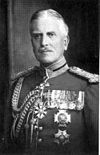 | 1871 | 1947 | 19357 June 1935[117] |
Edward VIII | — (Royal Family) |  | 1894 | 1972 | 1936-01-2121 January 1936[118] |
Sir Cyril Deverell | West Yorkshire Regiment |  | 1874 | 1947 | 193615 May 1936[119] |
George VI | — (Royal Family) |  | 1895 | 1952 | 1936-12-1212 December 1936[120] |
Edmund Ironside, 1st Baron Ironside | Royal Artillery |  | 1880 | 1959 | 194020 July 1940[121] |
Jan Smuts | — (South African Army) |  | 1870 | 1950 | 1941-05-2424 May 1941[122] |
Sir John Dill | Prince of Wales's Leinster Regiment |  | 1881 | 1944 | 194118 November 1941[123] |
John Vereker, 6th Viscount Gort, VC | Grenadier Guards |  | 1886 | 1946 | 1943-01-011 January 1943[124] |
Archibald Wavell, 1st Earl Wavell | Black Watch |  | 1883 | 1950 | 1943-01-011 January 1943[125] |
Alan Brooke, 1st Viscount Alanbrooke | Royal Artillery |  | 1883 | 1963 | 1944-01-011 January 1944[126] |
Harold Alexander, 1st Earl Alexander of Tunis | Irish Guards |  | 1891 | 1969 | 1944-06-044 June 1944[127] |
Bernard Montgomery, 1st Viscount Montgomery of Alamein | Royal Warwickshire Regiment |  | 1887 | 1976 | 1944-09-011 September 1944[128] |
Henry Maitland Wilson, 1st Baron Wilson | Rifle Brigade (Prince Consort's Own) |  | 1881 | 1964 | 1944-12-3929 December 1944[129] |
Sir Claude Auchinleck | 62nd Punjabis (Indian Army) |  | 1884 | 1981 | 19461 June 1946[130] |
William "Bill" Slim, 1st Viscount Slim | Royal Warwickshire Regiment |  | 1891 | 1970 | 19484 January 1948[131] |
Sir Thomas Blamey | — (Australian Army) | 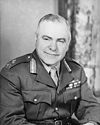 | 1884 | 1951 | 1950-06-088 June 1950[132] |
Prince Philip, Duke of Edinburgh | Royal Navy — (Royal Family) |  | 1921 | Living | 195315 January 1953[133] |
John Harding, 1st Baron Harding of Petherton | Somerset Light Infantry |  | 1896 | 1989 | 195321 July 1953[134] |
Prince Henry, Duke of Gloucester | King's Royal Rifle Corps |  | 1900 | 1974 | 195531 March 1955[135] |
Sir Gerald Templer | Royal Irish Fusiliers |  | 1898 | 1979 | 195627 November 1956[136] |
Sir Francis Festing | Rifle Brigade (Prince Consort's Own) |  | 1902 | 1976 | 19601 September 1960[137] |
Mahendra of Nepal | — (King of Nepal) |  | 1921 | 1972 | 196217 October 1962[138] |
Haile Selassie I | — (Emperor of Ethiopia) |  | 1892 | 1975 | 196520 January 1965[139] |
Sir Richard Hull | 17th/21st Lancers | 1907 | 1989 | 19658 February 1965[140] | |
Sir James Cassels | Seaforth Highlanders | 1907 | 1996 | 196829 February 1968[141] | |
Sir Geoffrey Baker | Royal Artillery | 1912 | 1980 | 197131 January 1971[142] | |
Michael Carver, Baron Carver | Royal Tank Corps | 1915 | 2001[143] | 197318 July 1973[144] | |
Sir Roland Gibbs | King's Royal Rifle Corps | 1921 | 2004[145] | 197913 July 1979[146] | |
Birendra of Nepal | — (King of Nepal) |  | 1945 | 2001[147] | 198018 November 1980[148] |
Edwin Bramall, Baron Bramall | King's Royal Rifle Corps |  | 1923 | Living | 19821 January 1982[149] |
Sir John Stanier | 7th Queen's Own Hussars | 1925 | 2007[150] | 1985-07-1010 July 1985[151] | |
Sir Nigel Bagnall | Green Howards | 1927 | 2002[152] | 19889 September 1988[153] | |
Richard Vincent, Baron Vincent of Coleshill | Royal Artillery | 1931 | 2018 | 19912 April 1991[154] | |
Sir John Chapple | 2nd King Edward VII's Own Gurkha Rifles (The Sirmoor Rifles) | 1931 | Living | 199214 February 1992[155] | |
Prince Edward, Duke of Kent | Royal Scots Greys — (Royal Family) |  | 1935 | Living | 199311 June 1993[156] |
Peter Inge, Baron Inge | Green Howards | 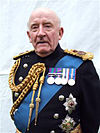 | 1935 | Living | 199415 March 1994[157] |
Charles, Prince of Wales | Welsh Guards, Royal Navy and Royal Air Force — (Royal Family) |  | 1948 | Living | 201216 June 2012[5] |
Charles Guthrie, Baron Guthrie of Craigiebank | Welsh Guards |  | 1938 | Living | 201216 June 2012[5] |
Michael Walker, Baron Walker of Aldringham | Royal Anglian Regiment | 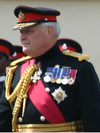 | 1944 | Living | 201413 June 2014[6] |
Notes
^ Titles and styles are those held by the field marshal when they died, or those currently held in the case of living field marshals; in most cases, these are not the same as the titles and styles held by an officer upon their promotion to the rank, nor (in the case of operational field marshals) those held when the officer retired from active service. All post-nominal letters, with the exception of "VC" (denoting the Victoria Cross) are omitted.
^ The regiment given is the regiment into which the field marshal was commissioned. This is not necessarily the regiment the officer first joined, nor is it necessarily the regiment in which the officer spent most of his career. A "—" indicates either that the officer did not lead a career in the British Army or that the officer was not initially commissioned into a formal regiment.
References
Footnotes
^ Brewer's Dictionary.
^ The Daily Telegraph & 12 April 2008.
^ abcdefg Heathcote, Introduction.
^ The Prince of Wales Archived 29 June 2012 at the Wayback Machine. The Queen appoints The Prince of Wales to Honorary Five-Star rank 16 June 2012
^ abc BBC News & 16 June 2012.
^ ab Ministry of Defence & 13 June 2014.
^ "Photograph of Prince Philip as Captain General Royal Marines wearing the insignia of a field marshal". Getty Images. 16 May 2013. Retrieved 20 December 2017..mw-parser-output cite.citation{font-style:inherit}.mw-parser-output q{quotes:"""""""'""'"}.mw-parser-output code.cs1-code{color:inherit;background:inherit;border:inherit;padding:inherit}.mw-parser-output .cs1-lock-free a{background:url("//upload.wikimedia.org/wikipedia/commons/thumb/6/65/Lock-green.svg/9px-Lock-green.svg.png")no-repeat;background-position:right .1em center}.mw-parser-output .cs1-lock-limited a,.mw-parser-output .cs1-lock-registration a{background:url("//upload.wikimedia.org/wikipedia/commons/thumb/d/d6/Lock-gray-alt-2.svg/9px-Lock-gray-alt-2.svg.png")no-repeat;background-position:right .1em center}.mw-parser-output .cs1-lock-subscription a{background:url("//upload.wikimedia.org/wikipedia/commons/thumb/a/aa/Lock-red-alt-2.svg/9px-Lock-red-alt-2.svg.png")no-repeat;background-position:right .1em center}.mw-parser-output .cs1-subscription,.mw-parser-output .cs1-registration{color:#555}.mw-parser-output .cs1-subscription span,.mw-parser-output .cs1-registration span{border-bottom:1px dotted;cursor:help}.mw-parser-output .cs1-hidden-error{display:none;font-size:100%}.mw-parser-output .cs1-visible-error{font-size:100%}.mw-parser-output .cs1-subscription,.mw-parser-output .cs1-registration,.mw-parser-output .cs1-format{font-size:95%}.mw-parser-output .cs1-kern-left,.mw-parser-output .cs1-kern-wl-left{padding-left:0.2em}.mw-parser-output .cs1-kern-right,.mw-parser-output .cs1-kern-wl-right{padding-right:0.2em}
^ Ashcroft, pp. 79–81.
^ London Gazette 4 September 1860.
^ London Gazette 3 June 1881.
^ London Gazette 26 November 1918.
^ London Gazette 24 December 1858.
^ Woodward, David R. (May 2006) [September 2004]. "Robertson, Sir William Robert, first baronet (1860–1933)". Oxford Dictionary of National Biography. Oxford University Press. doi:10.1093/ref:odnb/35786. Retrieved 2007-12-07. (Subscription required (help)).
^ ab Heathcote, pp. 122–125.
^ Heathcote, pp. 47–52.
^ Heathcote, pp. 320–326, Table 1.
^ ab Heathcote, pp. 166–167.
^ Heathcote, pp. 71–73.
^ Heathcote, pp. 52–53.
^ Heathcote, pp. 99–101.
^ Heathcote, pp. 97–99.
^ Heathcote, pp. 272–273.
^ Heathcote, pp. 285–287.
^ Heathcote, pp. 245–246.
^ Heathcote, pp. 211–212.
^ Heathcote, pp. 202–204.
^ Heathcote, pp. 234–235.
^ Heathcote, pp. 92–94.
^ Heathcote, pp. 302–303.
^ Heathcote, pp. 179–180.
^ Heathcote, pp. 127–130.
^ Heathcote, pp. 73–75.
^ Heathcote, pp. 23–26.
^ Heathcote, pp. 153–154.
^ Heathcote, pp. 178–179.
^ Heathcote, pp. 277–279.
^ Heathcote, pp. 82–83.
^ Heathcote, pp. 199–200.
^ Heathcote, pp. 112–113.
^ Heathcote, pp. 291–295.
^ Heathcote, pp. 116–118.
^ Heathcote, pp. 9–10.
^ Heathcote, pp. 301–302.
^ Heathcote, pp. 200–202.
^ Heathcote, pp. 222–223.
^ Heathcote, pp. 89–90.
^ Heathcote, pp. 182–183.
^ Heathcote, pp. 12–13.
^ Heathcote, pp. 297–299.
^ Heathcote, pp. 232–234.
^ Heathcote, pp. 154–155.
^ Heathcote, pp. 235–237.
^ Heathcote, pp. 267–269.
^ Heathcote, pp. 94–96.
^ Heathcote, pp. 63–64.
^ Heathcote, pp. 171–173.
^ Heathcote, pp. 90–92.
^ Heathcote, pp. 46–47.
^ Heathcote, pp. 148–150.
^ Heathcote, pp. 141–144.
^ Heathcote, pp. 69–71.
^ Heathcote, pp. 316–318.
^ Heathcote, pp. 146–148.
^ Heathcote, pp. 255–256.
^ Heathcote, pp. 60–63.
^ Heathcote, pp. 243–245.
^ Heathcote, pp. 121–122.
^ Heathcote, pp. 173–174.
^ Heathcote, pp. 105–108.
^ Heathcote, pp. 256–257.
^ Heathcote, pp. 318–319.
^ Heathcote, pp. 253–255.
^ Heathcote, pp. 223–225.
^ Heathcote, pp. 150–151.
^ Heathcote, pp. 207–208.
^ Heathcote, pp. 96–97.
^ Heathcote, pp. 237–238.
^ Heathcote, pp. 41–43.
^ Heathcote, pp. 257–259.
^ Heathcote, pp. 163–165.
^ Heathcote, pp. 270–272.
^ Heathcote, pp. 311–314.
^ Heathcote, pp. 246–250.
^ Heathcote, pp. 114–115.
^ Heathcote, pp. 83–85.
^ Heathcote, pp. 299–301.
^ Heathcote, pp. 230–232.
^ Heathcote, pp. 26–28.
^ Heathcote, pp. 314–316.
^ Heathcote, pp. 295–297.
^ Heathcote, pp. 125–127.
^ Heathcote, pp. 151–153.
^ Heathcote, pp. 59–60.
^ Heathcote, pp. 191–197.
^ Heathcote, pp. 135–137.
^ Heathcote, pp. 205–207.
^ Heathcote, pp. 228–230.
^ Heathcote, pp. 130–135.
^ Heathcote, pp. 225–228.
^ Heathcote, pp. 155–160.
^ Heathcote, pp. 115–116.
^ Heathcote, pp. 319–320.
^ Heathcote, pp. 240–243.
^ Heathcote, pp. 19–23.
^ Heathcote, pp. 303–308.
^ Heathcote, pp. 250–253.
^ Heathcote, pp. 39–41.
^ Heathcote, pp. 10–12.
^ Heathcote, pp. 43–45.
^ Heathcote, pp. 190–191.
^ Heathcote, pp. 208–211.
^ Heathcote, pp. 17–19.
^ Heathcote, pp. 176–178.
^ Heathcote, pp. 64–69.
^ Heathcote, pp. 197–199.
^ Heathcote, pp. 86–89.
^ Heathcote, pp. 219–222.
^ Heathcote, pp. 108–112.
^ Heathcote, pp. 101–102.
^ Heathcote, pp. 137–141.
^ Heathcote, pp. 185–190.
^ Heathcote, pp. 264–267.
^ Heathcote, pp. 102–105.
^ Heathcote, pp. 279–283.
^ Heathcote, pp. 287–291.
^ Heathcote, pp. 56–59.
^ Heathcote, pp. 13–17.
^ Heathcote, pp. 212–219.
^ Heathcote, pp. 308–311.
^ Heathcote, pp. 28–35.
^ Heathcote, pp. 259–264.
^ "No. 38930". The London Gazette (Supplement). 2 June 1950. p. 2811.
^ Heathcote, pp. 238–240.
^ Heathcote, pp. 167–171.
^ Heathcote, pp. 174–176.
^ Heathcote, pp. 273–277.
^ Heathcote, pp. 118–121.
^ Heathcote, pp. 204–205.
^ Heathcote, pp. 160–163.
^ Heathcote, pp. 180–182.
^ Heathcote, pp. 79–82.
^ Heathcote, pp. 37–39.
^ The Guardian & 12 December 2001.
^ Heathcote, pp. 75–79.
^ The Daily Telegraph & 2 November 2004.
^ Heathcote, pp. 144–146.
^ BBC News & 2 June 2001.
^ Heathcote, pp. 45–46.
^ Heathcote, pp. 53–56.
^ The Times & 13 November 2007.
^ Heathcote, pp. 269–270.
^ The Independent & 11 April 2002.
^ Heathcote, pp. 35–37.
^ Heathcote, pp. 283–285.
^ Heathcote, pp. 85–86.
^ Heathcote, pp. 113–114.
^ Heathcote, pp. 183–185.
General
Heathcote, Tony (1999). The British Field Marshals, 1736–1997: A Biographical Dictionary. Barnsley: Pen and Sword Books. ISBN 978-0-85052-696-7.
Ashcroft, Michael (2007). Victoria Cross Heroes. London: Headline Publishing Group. ISBN 978-0-7553-1633-5.
Specific
- "No. 22212". The London Gazette. 24 December 1858. p. 5516.
- "No. 22419". The London Gazette (Supplement). 4 September 1860. p. 3257.
- "No. 24981". The London Gazette (Supplement). 3 June 1881. p. 2859.
- "No. 31034". The London Gazette (Supplement). 26 November 1918. p. 14039.
"Field marshal". Brewer's Dictionary of Phrase and Fable. Edinburgh: Chambers Harrap. 2009. Retrieved 12 June 2011.
(subscription required)
"Telegraph style book: the Services". The Daily Telegraph. Telegraph Media Group. 12 April 2008. Retrieved 13 June 2011.
van der Vat, Dan (12 December 2001). "Obituary: Field Marshal Lord Carver". The Guardian. Guardian Media Group. Retrieved 11 June 2011.
"Obituaries: Field Marshal Sir Roland Gibbs". The Daily Telegraph. Telegraph Media Group. 2 November 2004. Retrieved 11 June 2011.
"Obituary: Field Marshal Sir John Stanier". The Times. Times Newspapers Ltd. 13 November 2007. Retrieved 11 June 2011.
"Obituary: Field Marshal Sir Nigel Bagnall". The Independent. Independent Print Limited. 11 April 2002. Retrieved 11 June 2011.
"Nepal mourns slain king". BBC News. BBC. 2 June 2001. Retrieved 11 June 2011.
"Prince Charles awarded highest military ranks by Queen". BBC News. BBC. 15 June 2012. Retrieved 16 June 2012.
"2014 Birthday Honours for service personnel and defence civilians". Ministry of Defence. Ministry of Defence. 13 June 2014. Retrieved 22 June 2014.
Commissioned officer ranks of the British Armed Forces | |||||||||||||
|---|---|---|---|---|---|---|---|---|---|---|---|---|---|
NATO rank code | Student officer | OF-1 | OF-2 | OF-3 | OF-4 | OF-5 | OF-6 * | OF-7 ** | OF-8 *** | OF-9 **** | OF-10 ***** | ||
Royal Navy | O Cdt | Mid | SLt | Lt | Lt Cdr | Cdr | Capt | Cdre | RAdm (list) | VAdm (list) | Adm (list) | Adm of the Fleet | |
Royal Marines | O Cdt | 2Lt | Lt | Capt | Maj | Lt Col | Col | Brig | Maj-Gen | Lt-Gen | Gen (list) | Capt-Gen | |
Army | O Cdt | 2Lt | Lt | Capt | Maj | Lt Col | Col | Brig | Maj-Gen (list) | Lt-Gen (list) | Gen (list) | Fd Mshl | |
Royal Air Force | Off Cdt / SO | APO / Plt Off | Fg Off | Flt Lt | Sqn Ldr | Wg Cdr | Gp Capt | Air Cdre | AVM | Air Mshl | Air Chf Mshl (list) | Mshl of the RAF | |